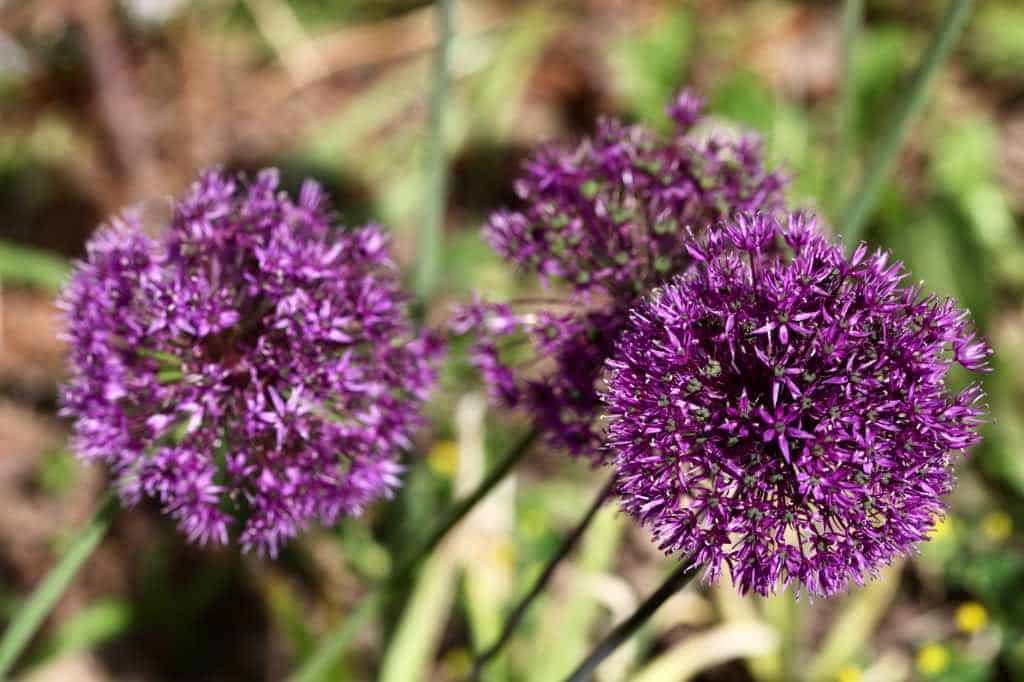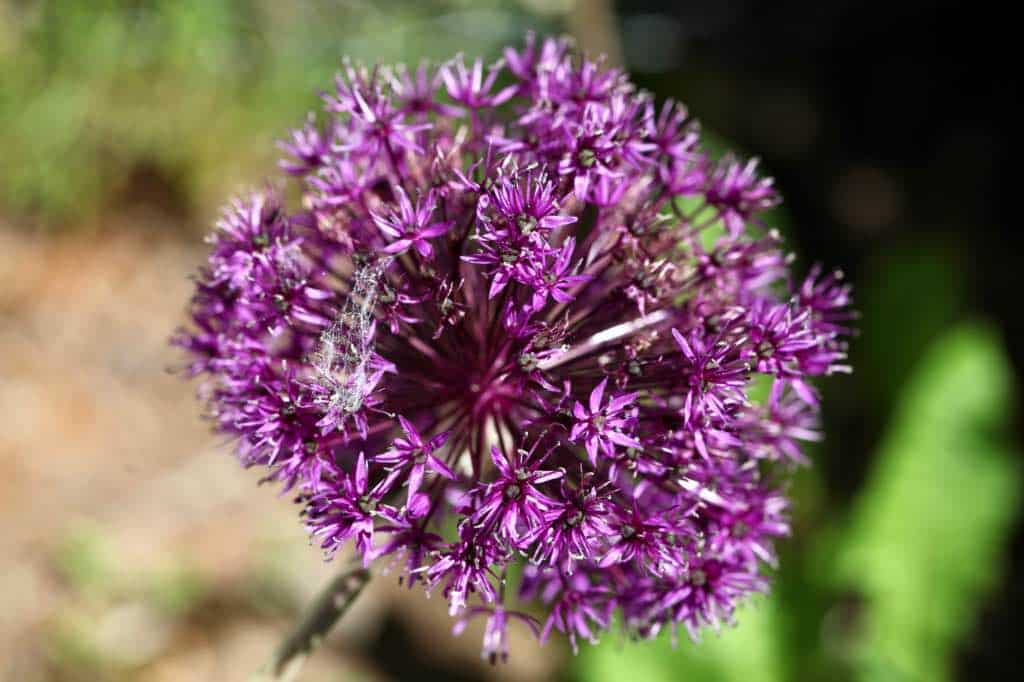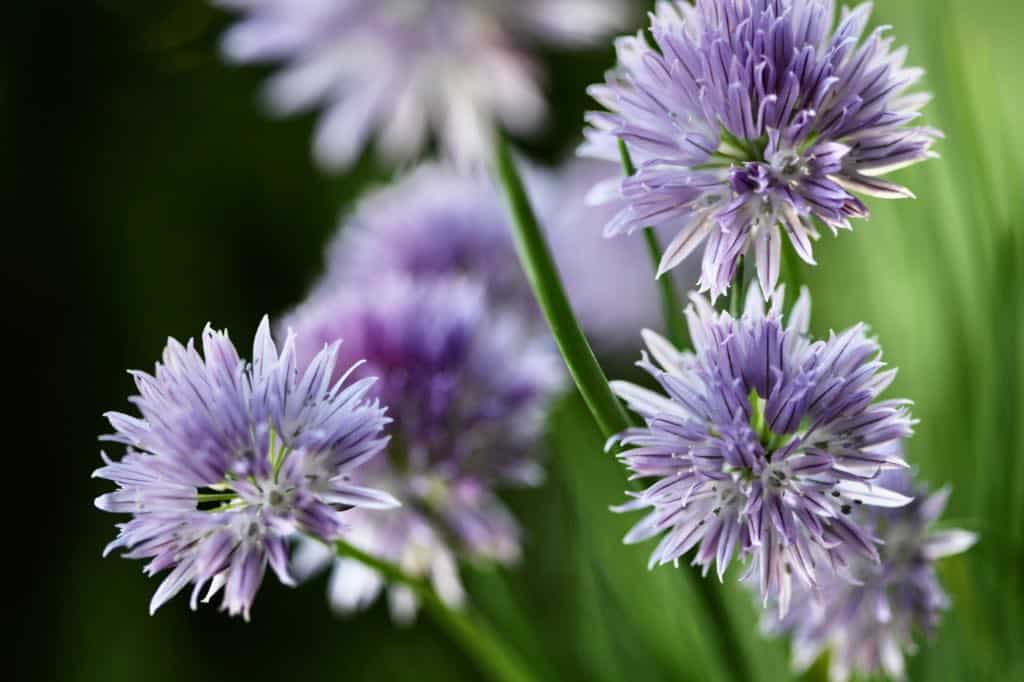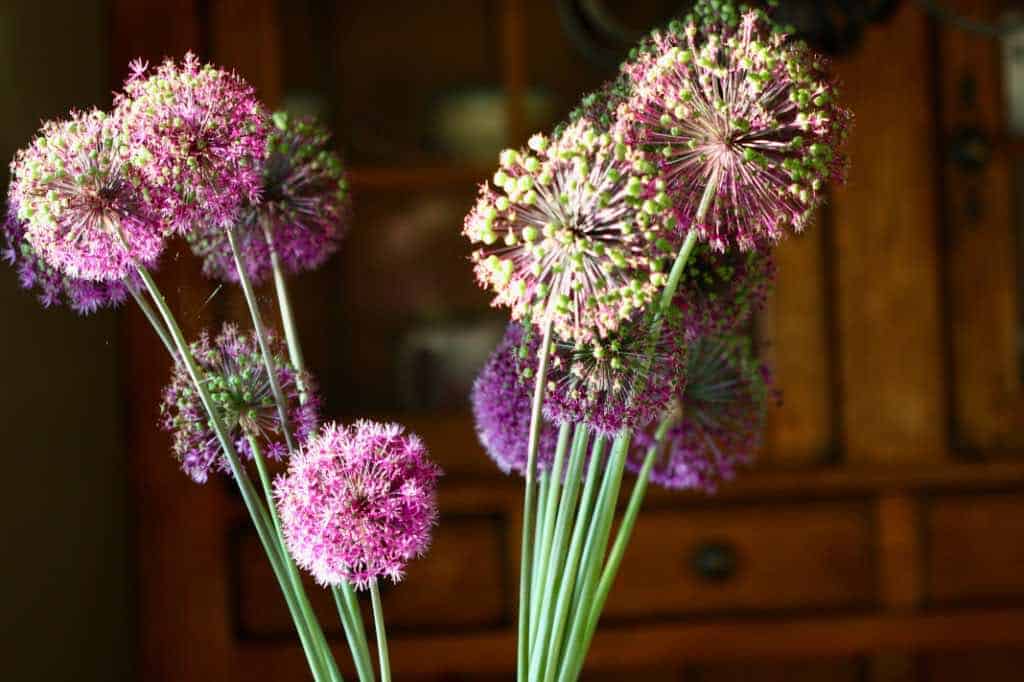Fall can be a busy time in the gardening world, and sometimes bulb planting gets delayed. Or sometimes we pick up some late season allium bulbs at the garden centre that need to be planted into the ground. If that’s the case, you may be wondering how late you can actually plant the allium bulbs, and still have beautiful spring blooms to look forward to.
Growing allium bulbs can be rewarding, because these spring plants offer so much beauty to the garden space.
There are many different types of ornamental allium bulbs, and most put on a magnificent flowering display in the late spring or early summer months.
The tall and stately bulbs look amazing when grown en masse, and can be easily grown by even a beginner gardener.
In this post we will have a look at some considerations for allium planting time, and explore how late in the season allium bulbs can be planted with success.
Alliums are popular bulbous flowering plants that include ornamental onions, garlic, leeks, chives, and hundreds of other species. Their globular flowerheads on top of long, slender stems create magical, sculptural effects in the garden. With their impressive versatility and diversity, it’s no wonder allium bulbs have become garden staples.
If you’re new to alliums, you may be wondering – can you plant allium bulbs in the spring? While most sources recommend fall planting, planting allium bulbs in spring is often successful too. Here’s what you need to know about the best planting time for allium bulbs and how to grow these beauties in spring.
Why Fall is the Recommended Planting Time
Most flower bulbs, including tulips, daffodils, crocuses and alliums, are traditionally planted in fall. This gives them the chill time they need to initiate root growth. When bulbs experience at least 8-12 weeks of temperatures between 35-48°F, biochemical changes occur that stimulate root production. Adequate root development is crucial because that’s how bulbs take up nutrients and water to support growth. Without a good root system, you won’t get many or any flowers.
Another reason for fall planting is to allow enough time for leaf growth Leaves produce the food bulbs need for the next year’s blooms Insufficient foliage means smaller or no flowers the following season, Fall-planted bulbs have full winter and spring for ample leaf production before they bloom in summer,
Finally, fall planting coincides with the natural growth cycle of bulbs. It fits their needs for chilling, rooting, foliage growth and blooming at the right times. Spring planting interrupts this cycle so flowers may be reduced or bloom may be delayed until the next year while bulbs adjust.
Spring Planting Can Work Well Too
Even though fall is ideal you can successfully plant allium bulbs in spring. The key is getting them in the ground as early as possible while soil is still cool. This gives bulbs a bit of chilling time to start the rooting process before warm weather arrives.
Aim to plant large bulbs like alliums about 4-6 weeks before your projected last spring frost. Smaller bulbs like crocuses, grape hyacinths and squills can go in 2-3 weeks before the frost date Prepare the soil well by mixing in compost or other organic matter to improve drainage
Plant bulbs at the recommended depth according to package directions. Space them appropriately for good air circulation. Water well after planting and cover the area with 2-3 inches of organic mulch. The mulch helps conserve moisture and keeps soil cooler a bit longer so bulbs can form roots.
Expect Some Differences With Spring Planting
When planted in spring rather than fall, bulbs may bloom at slightly different times, or flower size or quantity may be reduced. But with proper care, spring-planted bulbs can still thrive and put on a gorgeous display. It just takes patience and realistic expectations.
For example, tulips and daffodils may not bloom much if at all the first spring after planting. Often these bulbs need a full year to settle in before flowering. Flowering in year two and beyond should improve as bulbs become established.
Some alliums and other bulbs will still bloom decently the first year from spring planting. Flower size or number may be smaller than normal. But once settled in, bulbs should perform well in following years.
Tips for Successful Spring Bulb Planting
Here are some useful tips to help your spring-planted bulbs do their best:
-
Plant as early in spring as possible when soil is cool but workable.
-
Prepare soil well by mixing in compost or aged manure.
-
Choose a spot with good drainage – avoid soggy areas.
-
Plant at the proper depth according to package directions.
-
Space bulbs appropriately so air can circulate.
-
Water newly planted bulbs well then mulch to conserve moisture.
-
Fertilize lightly with bulb fertilizer or bone meal.
-
Allow foliage to die back naturally after blooming.
-
Leave cleanup of bulb beds until late fall to allow food production.
Enjoy the Versatility of Alliums
With their pleasing rounded shapes and vivid colors, alliums provide fabulous texture and vertical interest to gardens. They pair elegantly with broad-leaved plants like hostas. Try combining different allium varieties for a continuous bloom sequence. Foliage remains attractive long after flowers fade.
Though fall planting is best, with proper care allium bulbs can thrive when planted in spring too. The key is early planting while soil is still cool to allow some root growth before warm weather. So don’t be afraid to add allium bulbs to your spring garden shopping list. Just focus on choosing the right planting location and giving bulbs a little extra attention. In no time at all, you’ll be rewarded with a breathtaking allium display.

Tips For Planting Allium Bulbs
- Ornamental alliums will grow in usda hardiness zones 3 to 8.
- Plant spring blooming ornamental allium bulbs in the fall, allowing for at least 12 weeks of cold before spring.
- Choose a sunny spot for planting for the best flowering results.
- For a successful allium patch, a full sun location is ideal.

- Choose a fertile soil type with good drainage.
- Do not allow the bulbs to sit in poor draining soil, as this can cause bulb rot.
- This same concept applies to moisture provision.
- Too much water provision and dampness can also cause allium bulbs to rot.
- Water in when planting, and then water as needed in the spring, during dry periods.
- Alliums are known to be drought tolerant, however will droop if the soil becomes too dry. If you notice drooping, be sure to give the plants some water.
- Otherwise allow nature to take care of the moisture needs of the plants.

These are some considerations for planting allium bulbs:
The Benefits Of Allium
Alliums have multiple beneficial uses, including providing attractive flowers for the garden space, pest repelling properties, as well as culinary use.
Some alliums are very tall and stately, and make quite a visual impact, even when only a few specimens are planted. Others may be smaller, and yet still be very beautiful, especially when grown together in clumps.
Some alliums are grown for consumption, and are used regularly in culinary applications. Not all are edible however, such as the ornamental alliums, so know your alliums before consuming.
Alliums produce a chemical compound called sulphate, which contributes to the typical onion or garlic flavor of most of these plants.
The allium is considered to be a natural pest repellant due to it’s sulfur-like and oniony smell. The plants will deter aphids, grubs, nematodes, and even Japanese beetles.
These plants therefore make great companion plants for roses, as well as other plants in the garden.

For the sake of this post we will be discussing ornamental alliums, which are grown for the flower garden.
When they are in bloom, allium flowers look like fireworks in the garden. The spherical blooms consist of many tiny star shaped flowers, which extend out to form pom pom shaped clusters.
The many tiny individual flowers on individual stalks lend to a sparkling and dazzling display.

Most allium plants have purple flowers, although there are different varieties with different shades of purple. Some alliums have white blooms as well.
The flowers are perched atop strong stems, and generally do not require staking.
Ornamental alliums come in a variety of different sizes, from the tall and stately giant allium, to smaller, dainty, front of the border varieties.
Allium flowers are eye catching when in bloom, however they are also visually appealing when they are spent. The globe shaped seed pods which form after blooming are also intricate, and interesting in the garden.
Ornamental alliums make wonderful cut flowers, and look elegant in flower arrangements.

How to plant allium bulbs for beginners
FAQ
What happens if you plant allium in the spring?
Some allium varieties are also planted in spring, and these varieties do not require a winter chill before planting. Consider growing alliums in your garden bed. These interesting plants have an early bloom season, and look great in cottage gardens planted with tulips and daffodils.
What month is best to plant allium?
Alliums are amongst the most undemanding flower bulbs to plant, tolerating most types of soil and hardy down to zone 4. They should be planted in fall between September and November, before the soil freezes. You will rarely have to worry about watering them as they actually prefer dry conditions.
What’s the latest you can plant allium bulbs?
Allium bulbs should be planted in autumn for the best possible results however you can plant them as late as December if the bulbs are still healthy. Do not plant bulbs if they are mouldy, soft or rotten as this could affect the other bulbs in the area.
